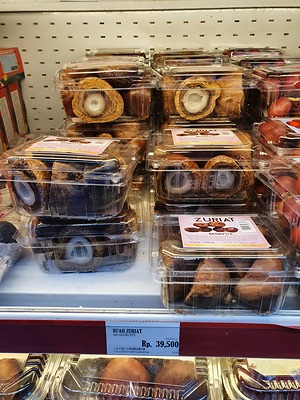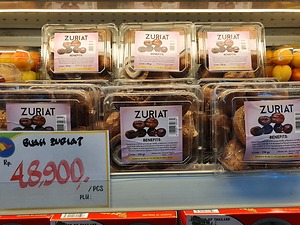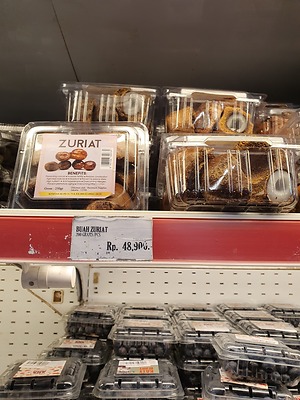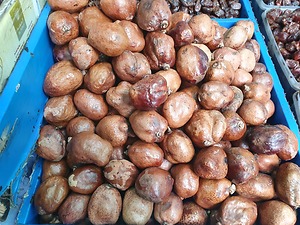

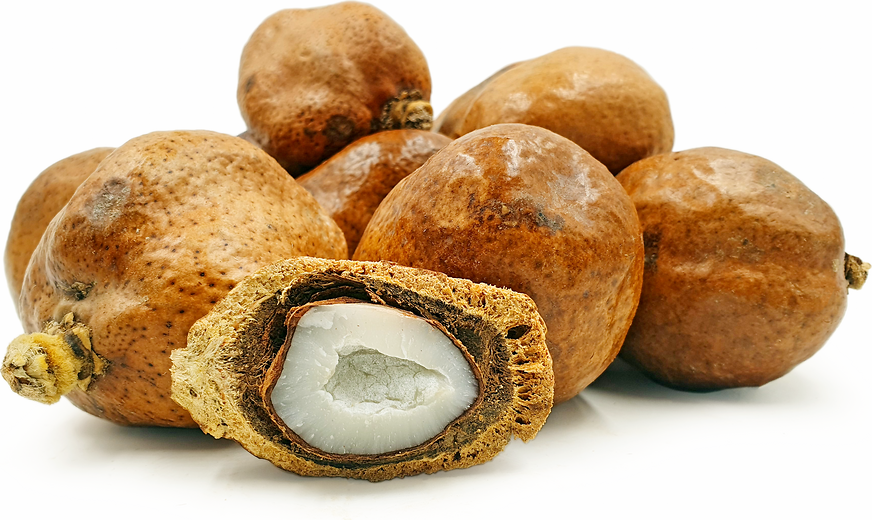
Zuriat Fruit
Estimated Inventory, lb : 0
Description/Taste
Zuriat fruits are large in size, averaging 6-10 centimeters in diameter, and have a globular to oval shape with an aromatic, sweet fragrance. The tough skin is brown, shiny, and woody with a bumpy surface covered in smooth divots. Underneath the flaky skin, the fibrous, spongy flesh is also brown and encases a large oval seed that is white, firm, and dense. Zuriat fruit is crunchy with a sweet-tart taste, often likened to the flavor of gingerbread.
Seasons/Availability
Zuriat fruit is available year-round.
Current Facts
Zuriat, botanically classified as Hyphaene thebaica, is the edible fruit that grows on a slender palm that can reach up to fifteen meters in height and belongs to the Arecaceae family. Also known by many local names including the Doum palm fruit and Gingerbread fruit, Zuriat fruits thrive in generally hot and dry climates, growing along waterways and waterholes. Zuriat fruits were once one of the most popular fruits in Ancient Egypt, used in culinary applications and medicinally, but the fruit has slowly faded from the spotlight over time. Today Zuriat fruit is typically found at specialty markets and is favored for its sweet and sour flavor.
Nutritional Value
Zuriat fruit contains vitamin C, which can help boost immunity in the body and contains antioxidants to fight free radicals and act as an anti-inflammatory. The fruit also contains vitamins and minerals that function as a diuretic and can help clean the digestive and circulatory system.
Applications
Zuriat fruit is best suited for both fresh and cooked applications such as sautéing, baking, and frying. Once the hard skin is removed, the flesh can be consumed fresh as a crunchy, flaky snack, and children are often seen in Egypt consuming the fibrous fruit out-of-hand. The flesh can also be boiled with honey, milk, or sugar and made into a tea, ground into a powder and mixed into beverages, juices, and smoothies, juiced when young, dried and ground into baked goods such as pancakes, cakes, and bread, or cooked into a syrup. The seed is also edible when unripe and can be cooked like a vegetable. Zuriat fruit will keep up to one week when stored in a cool, dry, and dark place.
Ethnic/Cultural Info
In Egypt, palms were highly respected for their ability to grow in harsh climates and were considered sacred by the Egyptians from their depictions of the palm on ancient tombs and artifacts. Zuriat fruit was also regarded as sacred and has been used medicinally in Egypt for thousands of years, believed to give strength and provide fertility. Eight baskets of Zuriat fruit were discovered in King Tutankhamun’s tomb, and the fruits were over three-thousand years old. In modern-day, Zuriat fruit is still believed by Egyptians to make women fertile, and the wood of the palm is used for construction. The hard, mature seeds of the fruit are also used for carving buttons and beads.
Geography/History
Zuriat fruit is native to northern Africa and the Arabian Peninsula and has been growing wild since ancient times. The fruit was consumed and used medicinally in Ancient Egypt, and the palm was then spread along the Nile River. Today Zuriat fruit can be found at local markets in Egypt, Ethiopia, Sudan, Kenya, Tanzania, Israel, Saudi Arabia, and Yemen. It is also exported to select markets in Asia and Southeast Asia.







